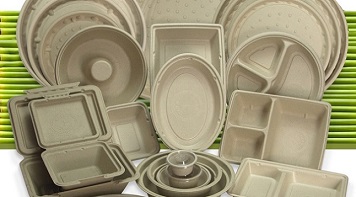 NATIONAL REPORT—With so much attention given to the problems that go along with the use of polystyrene (Styrofoam) in hotel foodservice operations, hoteliers have been turning to alternatives made from sugarcane, potato and vegetable starches, corn, beets, cassava and other materials. Selecting the eco-friendliest alternative to polystyrene is not easy, however. Molded fiber containers, paperboard containers, brown sandwich paper and other food packaging items have been found to contain PFAS chemicals that can migrate to food held in the items and linger for a long time in the human body—even promoting cancer. The chemicals can also contaminate soil and water. Even Whole Foods, known for its healthy foods and sustainability practices, was caught using containers with PFAS chemicals.
NATIONAL REPORT—With so much attention given to the problems that go along with the use of polystyrene (Styrofoam) in hotel foodservice operations, hoteliers have been turning to alternatives made from sugarcane, potato and vegetable starches, corn, beets, cassava and other materials. Selecting the eco-friendliest alternative to polystyrene is not easy, however. Molded fiber containers, paperboard containers, brown sandwich paper and other food packaging items have been found to contain PFAS chemicals that can migrate to food held in the items and linger for a long time in the human body—even promoting cancer. The chemicals can also contaminate soil and water. Even Whole Foods, known for its healthy foods and sustainability practices, was caught using containers with PFAS chemicals.
The Biodegradable Products Institute (BPI), the nonprofit organization that certifies products for compostability, clarified in late 2018 that makers of compostable foodservice products must phase out those products that do not meet a new standard of maximum 100 ppm PFAS by the end of this year. If a company’s product exceeds the 100 ppm level, it can no longer be called BPI Certified.
“For the 20 years that BPI has been certifying compostable products, the efficacy of our program has been driven by how well those products perform in the compost environments they are accepted into,” said Rhodes Yepsen, Executive Director of BPI. “Once composters and municipalities began telling us their concerns about fluorinated chemicals in foodservice packaging, we participated in studies and learned that it persists during the composting process, and is likely bioavailable to fruit and vegetable crops grown in the finished compost, so we knew we had to be proactive and update our certification requirements.”
PFAS Used Across Several Industries
According to BPI, fluorinated chemicals like PFAS are used across several industries, and are an effective, FDA-approved “grease-proofing” barrier used on some paper and molded pulp food packaging. Most BPI certified products already do not contain fluorinated chemicals, instead achieving water and grease barrier through the use of compostable biopolymers like PLA, PBAT, PBS, or PHA, as well as compostable waxes.
Kevin Duffy, President, Biodegradable Food Service, LLC, whose Earth Maize product meets all state and BPI requirements for less than 100 PPM of PFAS, says PFAS is used in fire-fighting as a foaming agent. “It becomes one with the water,” he says. “The heat turns the water into steam while the PFAS material settles into the ground. Every ounce of PFAS has never left the earth’s surface. It even rains down with the rainwater.”
The known extent of contamination of American communities with PFAS continues to grow at an alarming rate, with no end in sight. As of March 2019, at least 610 locations in 43 states are known to be contaminated, including drinking water systems serving an estimated 19 million people.
“The State of Washington is the first state to ban PFAS in food packaging and several will be following,” Duffy adds. “In New York it has passed the Senate. New Hampshire and Oregon have laws stating that PFAS cannot be exposed to children under the Toxic Free Kid Act.” In Rhode Island, the Prohibition of PFAs in Food Packaging Act was proposed to go into effect on January 1, 2020 but was denied by the state. To see which locations have banned PFAS, click here.
According to the Environmental Protection Agency (EPA), PFAs are linked to kidney and testicular cancer, thyroid disruption, high cholesterol, developmental disorders, decreased fertility, and damage to the immune system.
Center for Environmental Health Report
Early last year, the Center for Environmental Health (CEH) issued a report on hidden hazards in foodware. (Click here to access it.) CEH tested plates, bowls, clamshells and multi-compartment food trays for their total fluorine content. In total, over 130 products representing 39 manufacturers/brands were tested and classified as “non-fluorinated” or “fluorinated.” Fifty-seven percent of these products were fluorinated (with PFAS).
Products made of the following materials consistently tested as no or low-fluorine: bamboo, claycoated paper or paperboard, clear PLA, paper-lined with PLA, palm leaf, paper with unknown coatings, and uncoated paper. Products made of the following materials consistently tested as fluorinated: all molded fiber products such as wheat fiber (wheat straw or wheat stalk), “blend of plant fibers”, silver grass (miscanthus), and sugarcane waste (bagasse) including molded recycled paper and PLA-lined molded sugarcane (bagasse). Based on these findings, CEH recommends avoiding molded fiber foodware.
“Reusable foodware is the best choice for environmental and health reasons,” the report said. “Even the ‘best’ nonfluorinated disposable foodware creates avoidable waste, depletes natural resources, and raises concerns about other toxic chemicals, the environment, and human health.”
The BPI site lists all BPI approved companies and their products, down to the item number.
Watch Out for ‘Biodegradable’
In addition to understanding the potential hazards of some compostable foodservice containers, one should also understand what composting lingo really means and how long it will take for an item to actually compost and under what conditions.
Biodegradable Food Service’s Duffy says to beware of companies using the word “biodegradable.” “The Federal Trade Commission does not allow you to call a product ‘biodegradable,’” he says. A year ago, Amazon had to pay $1.5 million to settle allegations it broke California law on the marketing of plastics as “biodegradable” or “compostable.”
BPI verifies that products and packaging will successfully break down in professionally managed composting facilities, without there being chemicals harming the quality of that compost. According to BPI, while “biodegradable” does not have a particular time frame attached to it, “compostable” does. “Generally speaking, most composters would like the material they allow into their facilities to break down in fewer than 80 days,” BPI says.
Glenn Hasek can be reached at editor@greenlodgingnews.com.






